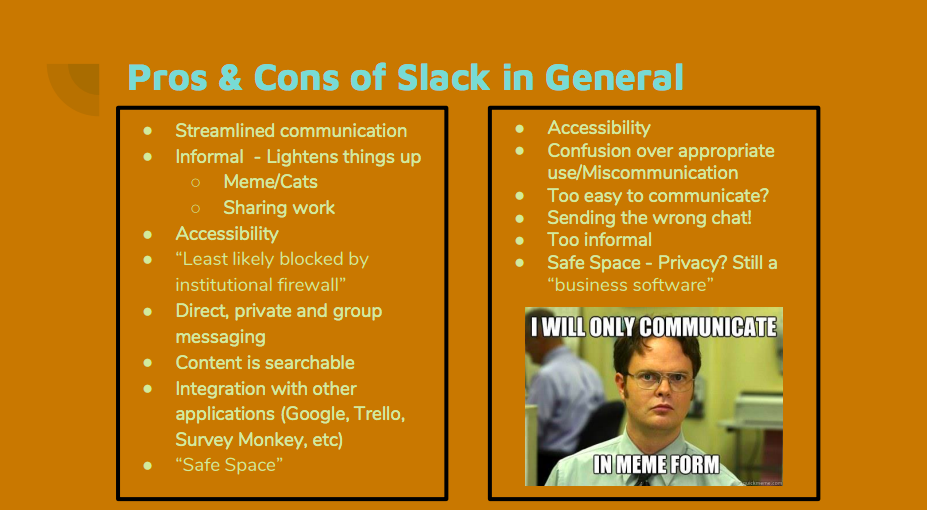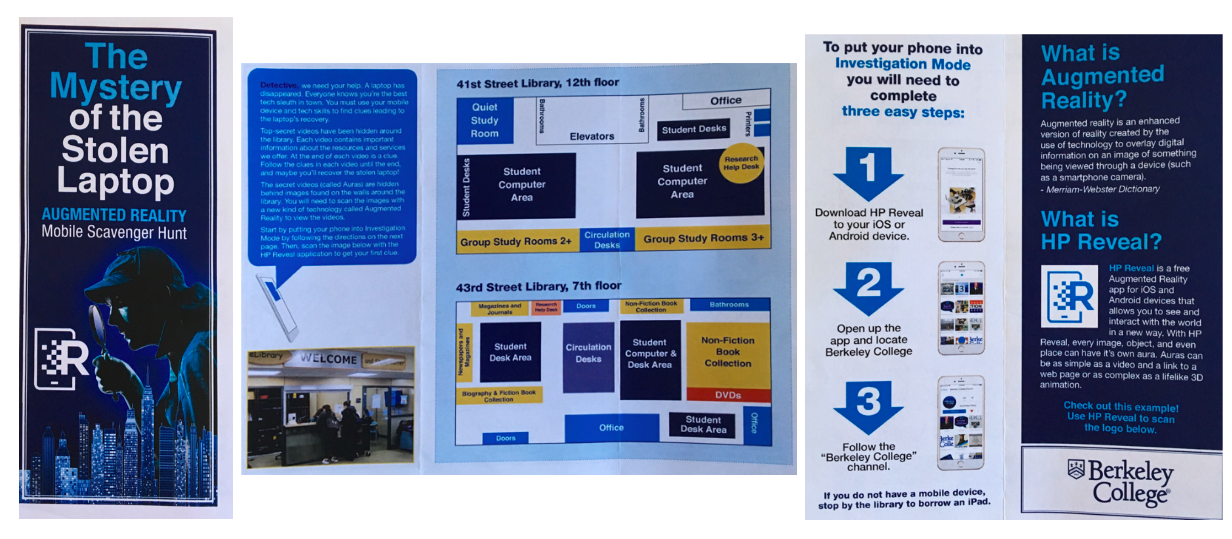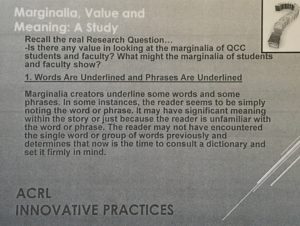On Friday, September 28, 2018, I attended an event entitled Innovative Practices in Academic Libraries, hosted by the Greater New York Metropolitan Area Chapter of the Association of College and Research Libraries (ACRLNY). Presenters reported on initiatives or studies in their respective institutions intended to increase engagement of staff and students or consider little-explored research angles. Since I am considering a career in academic libraries, I was curious to hear current professionals in the field describe the impact these innovations had in their institutions.
Using Slack to Improve Staff Engagement – Matthew Pavlick and Lauren DeVoe, Columbia University Libraries
Pavlick and DeVoe described the benefits and challenges of implementing the instant messaging program Slack among staff in their department. In discussing their reasons doing this, they described the lack of communication among different areas of the department before the introduction of this service, which created silos of information. In introducing Slack, Pavlick and DeVoe wanted to increase staff engagement and communication, encourage creativity collaboration, and streamline processes. Slack provides the flexibility to have individual as well as group conversations, and allows for the creation of different “channels,” that is to say, labeled threads of conversation kept separate from one another. Slack conversations are also fully searchable to allow for later information retrieval. The informal nature of Slack made it so that employees didn’t have to interrupt their workflow by physically getting up to ask a question, where they might then be worried about interrupting their colleague’s own workflow.
Although Pavlick and DeVoe described a largely positive experience in implementing Slack, they did mention that accessibility challenges may arise, wherein certain staff members, especially older people, may have trouble adopting this new technology. Others may simply be resistant to it because they don’t want to be burdened further additional forms of communication. Pavlick and DeVoe chose to make implementation of Slack optional for members of their department, but they would like at some point to make it mandatory and expand its use to their entire division.

Augmented Reality Library Orientation: Planning the “Case of the Missing Laptop” Scavenger Hunt – Samantha Kannegiser and Bill McNelis, Berkeley College
Kannegiser and McNelis related that, since Berkeley College has two campuses several blocks from each other in Manhattan, each with its own library, students are often unaware of or not taking advantage of the unique offerings of both libraries. Additionally, they mentioned the concept of library anxiety, which might keep students from exploring potentially valuable resources, and the fact that some students are first-generation college attendees and may not know about library resources in general. For these reasons, they felt that, as part of student orientation, they needed a way to showcase and explain library resources without having to take students from building to building themselves. Before the introduction of this augmented reality library orientation, library staff had been present at the general orientation, and students had to participate in a mandatory class that gave information on all of the libraries in each of the eight Berkeley campuses, but there was no dedicated orientation activity taking place inside the actual Manhattan libraries.
Kannegiser and McNelis decided on an augmented reality library orientation in the format of a scavenger hunt. They came up with a storyline about a missing laptop that the students needed to find using augmented reality clues. Each clue would take them to a different location in the libraries, where they would scan a “trigger image” using the HP Reveal augmented reality app to enable an informational video to play. The video would describe the resources at that location and provide clues for the next step of the hunt. This new form of library orientation has not yet been implemented in a widespread manner, but Kannegiser and McNelis hope that it will provide a fun alternate way to impart knowledge about each library’s resources.

Marginalia, Value and Meaning: a Study – Richard Mako, Queensborough Community College, CUNY
As part of his research, Mako decided to study the marginalia created in books belonging to the library at his institution. While the marginalia of famous people are often studied at great length, people don’t usually consider the meaning behind the marginalia of “regular” people. Mako decided to focus on the fiction section at his library, choosing ten books at random to analyze. He tallied instances of different types of marginalia in each book, including writing words or phrases, underlining, highlighting, encircling or boxing, and other symbols. He stated that he found a total of 2,963 instances of marginalia in these ten books, with 536 different symbols. Mako discussed the potential meaning behind these marginalia, and the possible motivations of students in making these notations, especially knowing they would have to return these library books.
While I found this presentation intriguing, I found it curious that Mako did not once mention the ethical or moral aspects of defacing library books in this way. While he discussed students’ motivations in making certain kinds of markings, he did not mention their motivations or thought processes in choosing to write in library books to such an extent as to interfere with other patrons’ reading experiences. I did bring this up during the question and answer period, but another event attendee disagreed with me, saying that she liked how Mako presented his findings in a manner divorced from ethical implications and more as one might study an art piece.

Conclusions
Overall, I found these presentations to be valuable contributions to the field of academic libraries. The presentations on Slack and library orientations provided ideas on how to energize and empower both staff and students in the library environment. The final presentation highlighted (no pun intended) the issue of how students use libraries and library materials. While I am not yet sure whether I will enter the academic library field after graduation, with these thought-provoking presentations in mind, I will be keeping an eye out for future ACRL events.